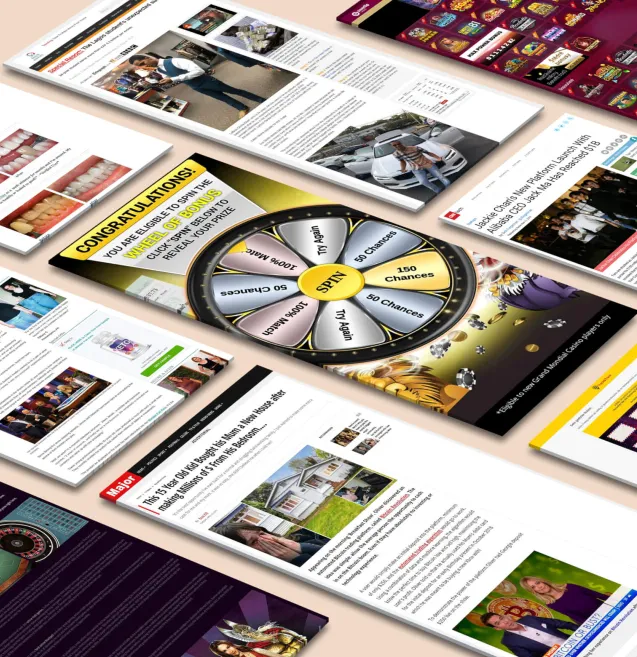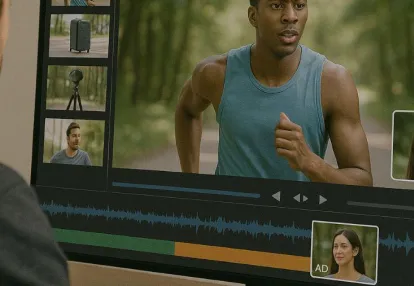
Our spy tools monitor millions of TikTok ads from over 55+ countries. Biggest TikTok Ad Library in E-commerce and Mobile Apps!
Try It FREEIf you're only running video ads on one platform, you're missing out. Cross-platform video ads are one of the most powerful strategies in modern digital marketing. Combining TikTok and YouTube creates an unbeatable duo for reaching audiences at every stage of their journey.
TikTok delivers rapid virality and trend-driven engagement that captures attention instantly. YouTube provides staying power through SEO capabilities and longer-form content that builds deeper connections. When you use both platforms together, you're not just doubling your reach—you're creating a comprehensive multi platform video marketing ecosystem.
The secret is in cross-platform storytelling. By running the same video creative on TikTok and YouTube (with strategic adaptations), you can maintain a unified brand message while still respecting the unique characteristics of each platform. This consistency greatly increases brand visibility. Your audience will come across your narrative multiple times in different contexts, reinforcing recognition and trust. The outcome? A cohesive brand experience that smoothly guides viewers from discovery to conversion, no matter where they first see your content.
TikTok video ads thrive in an environment built for immediacy and cultural relevance. The platform's audience craves content that feels native—raw, authentic, and plugged into current trends. You're working with users who scroll at lightning speed, making that first second absolutely critical. The demographic skews younger, with Gen Z and Millennials dominating the user base. These viewers arrive with entertainment as their primary intent, not product research. They're discovering brands through creative storytelling that doesn't feel like traditional advertising.
YouTube video ads operate in a completely different ecosystem. The platform supports everything from 15-second bumper ads to hour-long deep dives, giving you flexibility that TikTok simply can't match. YouTube's search functionality transforms videos into evergreen assets that continue generating views months or years after upload. The platform user behavior here reflects intent-driven consumption—people actively search for solutions, tutorials, reviews, and entertainment they've specifically chosen.
The demographic spread on YouTube is broader, capturing audiences from teenagers to retirees. This diversity directly influences your TikTok and YouTube ad strategy. Where TikTok demands you hook viewers instantly with trend-aligned content, YouTube allows you to build trust through detailed explanations and polished production. You're not just adapting video length; you're fundamentally shifting your approach to match how each platform's users consume and interact with content.
Consistent storytelling in video ads forms the backbone of successful cross-platform campaigns. Your brand narrative needs to remain recognizable whether someone encounters you on TikTok or YouTube. This doesn't mean posting identical content—it means maintaining core messaging, visual identity, and brand voice while adapting delivery methods.
Cross platform storytelling requires you to identify your brand's non-negotiables: specific color palettes, signature phrases, recurring characters, or distinctive editing styles. These elements anchor your content across both platforms. When Duolingo uses its mascot across TikTok's chaotic humor and YouTube's educational content, you see how a unified character maintains brand recognition despite different content approaches.
Adapting your storytelling technique involves understanding format constraints without compromising message integrity. You might present a product launch story as a 30-second TikTok teaser highlighting the "why now" urgency, then expand the same narrative into a 3-minute YouTube video exploring the development process. Both pieces share the same core message but respect each platform's consumption patterns.
Multi-part storytelling creates natural bridges between platforms. You can structure campaigns where TikTok videos pose questions or challenges that YouTube content answers in depth. A fitness brand might showcase a workout transformation teaser on TikTok, directing viewers to YouTube for the complete training program. This approach transforms passive viewers into active participants who seek out your content across multiple touchpoints, building deeper engagement through thematic synchronization.
Repurposing video creatives for ads transforms your content investment into a multiplier effect. You create once, then adapt strategically for each platform's ecosystem. This approach saves production time while extending your campaign's reach exponentially.
When you transform TikTok trends on YouTube Shorts, you're not simply uploading the same file. You take that trend-based hook and expand it with additional context. A 15-second TikTok dance challenge becomes a 60-second YouTube Short that includes the trend plus behind-the-scenes commentary or product demonstrations. The trend captures attention; the added detail drives understanding.
Content adaptation requires you to match each platform's production expectations:
Audio considerations make or break your cross-platform storytelling: running the same video creative on TikTok and YouTube demands different sound strategies. You leverage trending audio on TikTok to ride algorithmic waves and tap into existing conversations. On YouTube, you switch to royalty-free tracks or original compositions to avoid copyright strikes and maintain monetization eligibility. The visual story remains consistent; the audio layer adapts to platform-specific requirements and opportunities.
Cross platform video ads require careful design choices that respect each platform's unique features while also supporting your overall marketing objectives. It's important to create versions of your ads that feel natural and authentic to each platform, rather than just copying and pasting the same content everywhere.
For TikTok, your video should capture the platform's spontaneous and unpolished vibe. Start with an attention-grabbing hook within the first second—this could be a bold statement, surprising visual, or popular sound. Keep your message concise and straightforward, as TikTok users tend to scroll quickly through their feeds. To gain insights into successful TikTok ad campaigns and replicate their strategies for your own business, consider using tools like Anstrex Instream.
Your YouTube version will require a different approach. Here, you can elaborate on the same idea by providing additional context, showcasing product demonstrations, or sharing customer testimonials. The pacing can be slightly slower to allow viewers to absorb more detailed information. YouTube audiences generally expect higher production quality and more intricate storytelling.
Using TikTok as a top-funnel tool means leveraging it as your brand awareness driver. Your TikTok ads should pique curiosity and generate interest without overwhelming viewers with excessive information. Include calls-to-action that encourage engaged viewers to "watch the full version on YouTube" or "see how it works in our YouTube tutorial."
Your multi-platform video marketing strategy will thrive when each platform fulfills its specific purpose. TikTok serves as an introduction to your brand and captures attention, while YouTube nurtures that interest with comprehensive content that brings viewers closer to making a purchase decision. Strategic CTAs act as a bridge between these two experiences, guiding your audience through a seamless journey across both platforms.
Cross-promotion tactics transform your video ads from isolated pieces into interconnected experiences. You can post a 30-second teaser on TikTok showing the most compelling moment from your upcoming YouTube video, creating curiosity that drives viewers to watch the full version. Behind-the-scenes content works exceptionally well—showing your production process on TikTok while the polished final product lives on YouTube gives audiences a reason to follow you on both platforms.
Creator collaborations amplify your reach when you partner with influencers who maintain active presences on both TikTok and YouTube. You'll want to identify creators whose audiences align with your target demographic and whose content style complements your brand. These partnerships work best when the creator produces platform-specific content: a quick, trend-aligned TikTok featuring your product, paired with a detailed review or tutorial on their YouTube channel. This dual approach exposes your brand to the creator's established communities across both platforms, building trust through authentic endorsements while maximizing your campaign's visibility.
Social media diversification protects your video ad campaigns from unexpected disruptions. Relying solely on TikTok and YouTube exposes you to significant vulnerabilities—algorithm changes can tank your reach overnight, and platform-specific bans can eliminate your audience access entirely.
Instagram Reels serves as your essential third pillar. The platform's integration with Facebook's advertising ecosystem provides additional targeting capabilities while reaching audiences who may not actively use TikTok or YouTube. You're essentially building multiple safety nets for your content strategy.
Platform restrictions mitigation becomes straightforward when you distribute identical or adapted content across three or more channels. If TikTok suddenly restricts your account or YouTube changes its monetization policies, you maintain visibility and engagement through your other channels. Your brand narrative continues uninterrupted.
Cross-Platform Storytelling: Running the Same Video Creative on TikTok and YouTube extends naturally to Instagram Reels, where you can post the same 30-60 second videos with minimal adjustments. This approach maximizes your content investment while building redundancy into your marketing infrastructure. You're not putting all your eggs in one algorithmic basket.
Tracking video ad performance metrics requires a platform-specific approach. On TikTok, you'll want to monitor view-through rates, shares, and completion rates—metrics that signal viral potential and engagement depth. YouTube demands attention to watch time, click-through rates, and subscriber conversions, which reveal how well your content holds attention and drives action.
Campaign optimization thrives on comparative analysis. You'll discover TikTok audiences might engage heavily with the first three seconds while YouTube viewers commit to longer narratives. These audience insights shape your creative decisions—perhaps your TikTok hook needs sharpening while your YouTube intro could extend slightly.
However, it's crucial to remember that each digital platform and placement is different, requiring unique creative. This is where cross-platform optimized creative comes into play. By exploring examples of brands that have successfully optimized their creative for cross-platform campaigns, you can gain valuable insights.
Iterative testing becomes your competitive advantage. Test different:
You'll notice patterns emerge—TikTok might favor raw authenticity while YouTube responds to polished thumbnails. Use these insights to refine your creative elements continuously, letting data guide your storytelling adaptations rather than assumptions about what works.
Cross-platform storytelling benefits your brand by creating multiple touchpoints with audiences where they already spend their time. You've seen how TikTok's viral energy and YouTube's depth work together to amplify your message. The key is respecting each platform's unique culture while weaving a consistent thread through your content.
Maximizing brand visibility happens when you stop treating platforms as isolated channels. Think of TikTok and YouTube as complementary stages for your brand story—one captures attention quickly, the other builds lasting relationships. As video marketing evolves, expect AI-driven personalization and interactive storytelling to reshape how you connect across platforms. Integrated video marketing isn't just a strategy; it's becoming essential for brands that want to stay relevant in an increasingly fragmented digital landscape.
Receive top converting landing pages in your inbox every week from us.
Quick Read
This blog uncovers how brands can maximize their reach by leveraging cross-platform video ads on TikTok and YouTube. It explains how to adapt creative content for each platform while maintaining a consistent brand message. Readers will gain insights into audience targeting, engagement metrics, and performance tracking to optimize results. Perfect for marketers aiming to boost visibility and drive conversions through dynamic video advertising.
David Kim
7 minNov 17, 2025
Tips & Tricks
In-stream ads are video advertisements that play before, during, or after your streaming content on platforms like YouTube, OTT services, and social media channels. These ads represent a critical revenue stream in TikTok-ads-payment-problems-how-to-add-a-payment-method digital advertising, particularly as more viewers shift from traditional TV to streaming platforms. You're essentially capturing your audience's attention while they're already engaged with video content—making it one of the most effective advertising formats available today.
Dan Smith
7 minNov 11, 2025
Announcement
Measuring watch-through rates has become the defining metric separating successful video campaigns from those that fall flat in 2025. Watch-through rate (WTR) tells you exactly what percentage of your video viewers actually watch—not just how many people clicked play and scrolled away three seconds later.
Priya Kapoor
7 minNov 5, 2025




